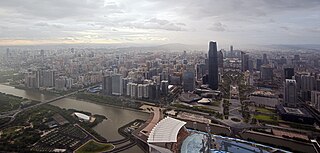Related Research Articles

Rural flight is the migratory pattern of peoples from rural areas into urban areas. It is urbanization seen from the rural perspective.

Urbanization refers to the population shift from rural to urban areas, the corresponding decrease in the proportion of people living in rural areas, and the ways in which societies adapt to this change. It is predominantly the process by which towns and cities are formed and become larger as more people begin living and working in central areas.

Man and the Biosphere Programme (MAB) is an intergovernmental scientific program, launched in 1971 by UNESCO, that aims to establish a scientific basis for the improvement of relationships between people and their environments.
The UNESCO World Network of Biosphere Reserves (WNBR) covers internationally designated protected areas, known as biosphere reserves, which are meant to demonstrate a balanced relationship between people and nature. They are created under the Man and the Biosphere Programme (MAB).
The International Research and Training Centre for Rural Education (INRULED) is a training and research centre located in the People's Republic of China. The main sponsors of INRULED are the Chinese government and UNESCO.

The Golden Gate Biosphere Network is an internationally recognized voluntary coalition of federal, state, and local government agencies, nonprofit organizations, universities, and private partners within the Golden Gate Biosphere (GGB) region. The Network works towards protecting the biosphere region’s biodiversity and conserving its natural resources to maintain the quality of life for people within the region. The Network has been part of the UNESCO Man and Biosphere Programme since 1988 and is part of the US Biosphere Network and EuroMAB. It is recognized by UNESCO due to the significant biodiversity of the region, as well as the Network's efforts to demonstrate and promote a balanced relationship between humans and the biosphere.
The German Commission for UNESCO is one of 195 National Commissions for UNESCO worldwide, a unique structure in the UN system, foreseen by UNESCO's constitution of 1946. The German Commission was founded on May 12, 1950, one year before West Germany was officially admitted to UNESCO. It has a liaison function for German Multilateral Foreign Cultural Policy; thus, its regular budget is financed by the Foreign Office. It is a chartered non-profit voluntary association with up to 114 members: Its members represent the German Federal government and the governments of the Laender, representatives of important German institutions working within UNESCO's fields of competence as well as individual experts.
Over the past decade, there has been an increase in the use of information and communications technologies (ICTs) in China. As the largest developing country in the world, China faces a severe digital divide, which exists not only between Mainland China and the developed countries, but also among its own regions and social groups.

Urbanization in China increased in speed following the initiation of the reform and opening policy. As of 2022, China had an urbanization rate of 64.7% and was expected to reach 75-80% by 2035.
The United Nations Educational, Scientific and Cultural Organization is a specialised agency of the United Nations (UN) aimed at promoting world peace and security through international cooperation in education, arts, sciences and culture. It has 193 member states and 12 associate members, as well as partners in the non-governmental, intergovernmental and private sector. Headquartered at the World Heritage Centre in Paris, France, UNESCO has 53 regional field offices and 199 national commissions that facilitate its global mandate.

An urban biosphere reserve is an attempt to apply the biosphere reserve concept to urban areas by the MAB Programme of UNESCO. Through urban planning and ecosystem management, an urban biosphere reserve is expected to support sustainable development and conservation. Brighton and Hove is bidding to become the world's first urban biosphere reserve.
Under UNESCO’s Man and the Biosphere Programme, there are 302 biosphere reserves recognized as part of the World Network of Biosphere Reserves in Europe and North America. These are distributed across 36 countries in the region.
The Kruger to Canyons Biosphere Region is a biosphere reserve situated in the north eastern region of South Africa, straddling Limpopo and Mpumalanga Provinces. In 2001, under the supervision of the then Department of Environmental Affairs (DEA), the Kruger to Canyons Biosphere Region was officially ratified by UNESCO as part of the Man and the Biosphere (MaB) Programme. UNESCO's Man and the Biosphere Programme provides a framework for exploring local solutions to challenges by mainstreaming biodiversity conservation and sustainable development, integrating economic, social and environmental aspects and recognizing their vital linkages within specific learning landscapes adjacent to Protected Areas.

Cu Lao Cham Marine Park also known as Cham Islands Biosphere Reserve is part of the eight islets of the Chàm Islands, located in the South China Sea under the administration of Tân Hiệp Commune and Hội An town, in Quảng Nam Province, Vietnam. The terrestrial and coastal ecosystems of the islands have been recognized as a global Biosphere Reserve by UNESCO on 26 May 2009 under its 'Man and the Biosphere Programme' for its rich biodiversity value. The eco system also includes the ancient Hội An, which is 20 kilometres (12 mi) away from the islands, a UNESCO World Heritage Site.
Overurbanization is a thesis originally developed by scholars of demography, geography, ecology, economics, political science, and sociology in thrergence of International Nongovernmental Organizations Amid Declining States. The term is intentionally comparative and has been used to differentiate between developed and developing countries. Several causes have been suggested, but the most common is rural-push and urban-pull factors in addition to population growth.
Urbanization in India began to accelerate after independence, due to the country's adoption of a mixed economy, which gave rise to the development of the private sector. The population residing in urban areas in India, according to the 1901 census, was 11.4%, increasing to 28.53% by the 2001 census, and is now currently 34% in 2017 according to The World Bank. According to a survey by UN, in 2030 40.76% of country's population is expected to reside in urban areas. As per World Bank, India, along with China, Indonesia, Nigeria, and the United States, will lead the world's urban population surge by 2050.
The Brighton and Lewes Downs Biosphere Reserve is a UNESCO Biosphere Reserve located in Sussex on the southeast coast of England near the city of Brighton and Hove. Forming a central unit of the hills of the South Downs National Park, it is centred on the Brighton chalk block that lies between the River Adur in the west and the River Ouse in the east. Chalk downland makes up the principal terrestrial landscape of the area, bounded at each end by the two river valleys. The coastline is dominated by impressive chalk cliffs in the east and urbanized plains in the west, running to the estuary of the River Adur at Shoreham-by-Sea. The area is nationally and internationally renowned for its arts and culture, distinctive settlements, independent mindset and its links to the surrounding iconic English landscape of downland, white chalk cliffs and beaches.
Boshra Salem is a professor, founder and the Chair of the Department of Environmental Sciences at Alexandria University in Alexandria, Egypt. She is president of Unesco's Man and the Biosphere (MAB) International Coordinating Council (ICC) and serves on the International Council for Science (ICSU)'s Committee for Scientific Planning & Review. She has received a number of awards, including being recognized as an outstanding female scientist in the Women in Science Hall of Fame by the Embassy of the United States in Cairo, Egypt.

Reza Ardakanian is an Iranian professor, politician and former Minister of Energy of Iran, a position he had held from 29 October 2017 to 25 August 2021. He was previously deputy energy minister in the 1980s and 1990s and has been involved with UN-Water.

Sustainable Development Goal 11, titled "sustainable cities and communities", is one of 17 Sustainable Development Goals established by the United Nations General Assembly in 2015. The official mission of SDG 11 is to "Make cities inclusive, safe, resilient and sustainable". The 17 SDGs take into account that action in one area will affect outcomes in other areas as well, and that development must balance social, economic and environmental sustainability.
References
- ↑ , UNESCO-CHIC Biosphere Integrated Rural Urbanization Project (BIRUP).